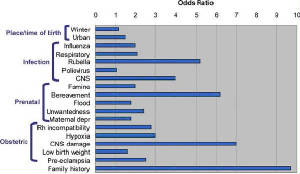
A recent study called the “famous twins study” (Tsuang, 2001) was performed by Tsuang et al. to explain
the heritability of schizophrenia in twins. He reproduced the ideas that surround the chances of being diagnosed with schizophrenia
when you are born as a twin. He gives the example of monozygotic (identical) twins sharing “100% of their genes and
have a 50% chance of developing schizophrenia if the other twin has the illness” (Tsuang, 2001). In comparison, fraternal
or dizygotic twins only have a 9% chance of developing the illness because the share only half of their genes. The study shows
that the more genes that are shared between two family members, the greater the risk of developing the heritable disease.
Through the study, Tsuang et al. discovered that even though identical twins share 100% of their genes, the percentage of
developing the disease, if one twin expresses it, is only 50%. The reasons behind the percentage being at such a moderate
level is due to the environmental factors that play a role in development. The study proposed “then one would expect
to find a risk rate of 100% in monozygotic twins, since they share 100% of their genes” (Tsuang, 2001). Yet, since there
is only a 50% chance of the other twin developing the disease, Tsuang proposes that there must be an outside factor that is
involved. His states that “it’s clear that environmental factors play a significant contributory role in determining
an individual’s vulnerability for developing schizophrenia” (Tsuang, 2001). He discusses that a Danish adoption
study states “the schizophrenia phenotype results from the additive effects of multiple genes and environmental factors”
(Tsuang, 2001), yet his aspect of the results “explains that, instead, these two factors contribute in an interactive
manner” (Tsuang, 2001). This theory is widely known as the “Diathesis-Stress
Model” (Adams, 2004). It discusses that genetic variance cannot account
for all the aspects of schizophrenia, and that “the development of schizophrenia, therefore, must depend on the interaction
between a genetic predisposition and the environment” (Adams, 2004).
These outside environmental factors “revolve around one
prominent feature: a stressor” (Adams, 2004), and schizophrenia results from that stressor in the environment. The Diathesis-stress
model discusses “that this stressor sets off some genetic predisposition for the disorder” (Adams, 2004). The
outside environmental factors that can contribute to schizophrenia are listed in Figure 2 below. Such factors can consist
of the month one was born in, family history, and whether one was born in an urban environment (Schizophrenia, 2004)
|

